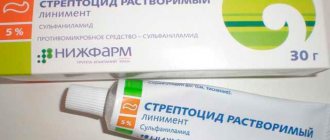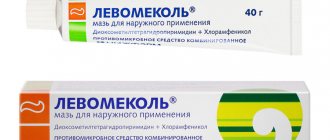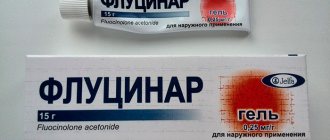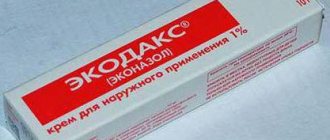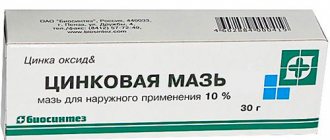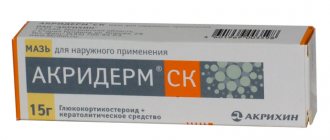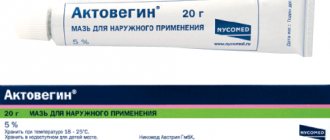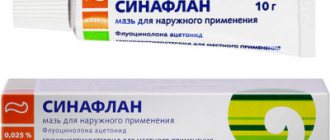If a fungal infection develops, regardless of the cause of the disease, it is necessary to begin treatment as soon as possible. Clotrimazole ointment is an antimycotic agent that has been proven for decades and is highly effective.
The use of antifungal ointment Clotrimazole is indicated for the treatment of fungal infections of the skin, nails, mycoses of natural folds, erytaplasma, pink and pityriasis versicolor. Used to treat thrush in men and women. Great for relieving possible vaginal infections before childbirth.
The effectiveness of the drug has been proven in cases where a secondary bacterial infection occurs in the form of purulent skin lesions, joining a fungal infection. Clotrimazole is active against almost all types of fungi; it helps eliminate yeast, mold and other types of fungal infections.
Compound
Gel 1% contains clotrimazole at a concentration of 10 mg/g, propylene glycol, macrogol 400, carbomer , rectified ethyl alcohol 96% from food raw materials, glycerol , sage ethereal extract.
Cream composition 1%: clotrimazole at a concentration of 10 mg/g, cetostearyl and benzyl alcohols, polysorbate 60, synthetic spermaceti, octyldodecanol, sorbitan stearate, water.
Composition of the ointment 1%: clotrimazole at a concentration of 10 mg/g, polyethylene oxides 400 and 1500, propylene glycol, methylparaben, nipagin.
Composition of the 1% solution: clotrimazole at a concentration of 10 mg/ml (in terms of dry matter), polyethylene glycol 400, propylene glycol, ethanol 96%.
Composition of suppositories: one suppository contains 100 mg of active substance and base in the volume necessary to obtain a suppository weighing 2 g. Clotrimazole suppositories contain semi-synthetic glycerides as a base.
Composition of tablets: 100, 200 or 500 mg of clotrimazole, lactose in the form of monohydrate, potato starch, adipic acid, sodium bicarbonate, silicon dioxide in colloidal form, sodium lauryl sulfate.
Analogues of the drug
Clotrimazole is the name of the active ingredient and trade name. You can purchase other medications based on this chemical compound at the pharmacy.
Popular analogues:
- Clotrimazole-TEVA
- Kanizon.
- Candide.
Analogue
Analogues can be used with the permission of a doctor.
Release form
- gel 1% (pack of 20 and 40 g);
- cream 1% (tubes 15, 20, 30 and 50 g);
- ointment 1% (tubes 15, 20, 30 and 40 g);
- 1% solution (15 ml bottles);
- vaginal suppositories 0.1 g (package No. 6);
- vaginal tablets 0.1, 0.2 or 0.5 g (packaging No. 1, No. 3, No. 6; tablets are equipped with an applicator).
Clotrimazole tablets and vaginal suppositories have an ATC code different from other dosage forms of the drug - G01AF02.
Clotrimazole can also be produced in the form of granules, powder for external use, or spray.
The drug is intended for local (including intravaginal) and external use; tablets for oral administration are not available.
Pharmacodynamics and pharmacokinetics
Clotrimazole is an imidazole .
In vitro, exhibits high activity against the most pathogenic fungi , which can cause serious infectious complications, namely:
- dermatophytes (Microsporum sp., Epidermophyton floccosum, Trichophyton sp.);
- yeast-like fungi (Cryptococcus neoformans, Candida sp.);
- dimorphic fungi (Histoplasma capsulatum, Paracoccidicides brasiliensis, Coccidiodes immitis).
The mechanism of action of clotrimazole is based on its ability to block the synthesis of proteins, nucleic acids and ergosterol, which is necessary for the construction of cell membranes of fungi. As a result, the cell membranes of the fungi are damaged and the cells die.
At low concentrations, clotrimazole has a fungistatic effect. If the dose exceeds 20 mcg/ml, the drug has a fungicidal effect, and not only on proliferating cells.
When used in high doses, it helps to increase the concentration of hydrogen peroxide in the fungal cell to a toxic value and, as a result, destroys the fungal cells
When applied topically, the drug is absorbed by the epidermis . The highest concentration of the substance is determined in the reticuloderm . It is also able to penetrate the keratin of nails.
Clotrimazole enters the systemic circulation in very small quantities. Metabolized in the liver to inactive substances that are excreted from the body in feces and urine.
When administered intravaginally, 5 to 10% of clotrimazole is absorbed. The absorbed substance is metabolized in the liver. Metabolic products are excreted in bile.
Effect of the drug
Clotrimazole has a wide spectrum of action; it is effective against a large number of types of fungi. The antimycotic effect of clotrimazole, which is an imidazole derivative, is due to disruption of the most important processes in the fungal cell. The active substance negatively affects the synthesis of ergosterol, a component of cell membranes. As a result, the permeability of the membranes becomes higher, which provokes lysis and death of the cell.
The drug has a fungicidal and fungistatic effect depending on the amount of the substance applied.
Clotrimazole also acts by one more mechanism, which only increases its effectiveness. When interacting with cell enzymes, the substance causes an increase in the concentration of hydrogen peroxide. The level of the latter becomes toxic, fungal particles are destroyed.
In the form of an ointment, Clotrimazole helps against diseases caused by the following mycoses:
- dermatophytes;
- mold fungi;
- yeast fungi - candida and others;
- fungus that causes tinea versicolor - Malazessia furfur;
- mycosporum;
- dermatophyton;
- trichophyton;
- Cryptococcus;
- dimorphic fungi.
The drug also helps against the causative agent of erythrasma - corynebacterium, which is not a mycotic, but a bacterial cell. As an antimicrobial agent, Clotrimazole can be used against staphylococci and streptococci, Trichomonas, and a number of gram-negative bacteria.
WE RECOMMEND THE ARTICLE!
Sebozol helps solve the problem of infectious and fungal infections of the scalp. Read more >>
The product does not have a systemic effect, its penetrating ability is low. During treatment, clotrimazole is poorly absorbed through the skin and mucous membranes, but can accumulate in the stratum corneum of the nails. Clotrimazole is almost not detected in the dermis and subcutaneous tissue.
Indications for use: what is Clotrimazole ointment, cream, gel, suppositories and tablets for?
What do Clotrimazole ointment, gel, cream and solution help with?
The drug is prescribed for the treatment of fungal infections of the skin , which are caused by molds and yeasts , dermatophytes and other pathogens sensitive to clotrimazole.
They are also used as remedies for lichen caused by Malassezia furfur and erythrasma (caused by Corynebacterium minutissimum).
Clotrimazole ointment, cream, gel and solution help: against nail fungus ( onychomycosis , fungal paronychia ), trichophytosis , dermatophytosis , fungal erosion and diaper rash, candidiasis , microsporia , athlete's foot , dermatomycosis , complicated by secondary pyoderma mycoses .
Indications for the use of ointment, gel, cream and solution include infectious diseases, pathogens that are resistant to nystatin and a number of other antifungal agents.
for the treatment of pityriasis rosea , since this disease is most likely of viral or infectious-allergic origin , and may also be the body’s response to a severe shock or nervous breakdown. Clotrimazole is effective against fungal infections .
The use of Clotrimazole ointment, gel and cream with Clotrimazole in gynecology is indicated:
- for the treatment and prevention of thrush ;
- for the prevention of repeated fungal infections of the female reproductive system , which develop during long-term treatment with antibiotics or against the background of immunodeficiency conditions.
Also, solution, gel, cream and ointment in gynecology are used to sanitize the genital tract before delivery.
Candles - what are they for?
The indication for the use of vaginal suppositories is vaginal candidiasis and genital superinfections caused by microorganisms sensitive to clotrimazole. The drug is prescribed to women and, after the onset of sexual activity, to teenage girls.
What are Clotrimazole tablets for?
Clotrimazole tablets are used to treat blastomycotic infections of the vulva and vagina . In particular, the drug is prescribed for vaginitis caused by fungi of the genus Candida (including diseases caused by strains resistant to nystatin ), caused by other pathogens sensitive to clotrimazole, superinfections of the genital organs , for sanitization of the genital tract before delivery.
Main indications
This remedy has a variety of indications related to different areas of medicine. In the form of an ointment, Clotrimazole is used for dermatitis caused by fungal pathogens and for mycotic diseases:
- stop;
- fingers and toes;
- open areas of skin;
- palms;
- skin folds;
- periungual ridges;
- interdigital spaces;
- nails
The drug is most active against dermatophytes and yeast fungi. With its help you can get rid of dermatomycosis, mycotic paronychia, canidomycosis, skin microsporia, trichophytosis and epidermophytosis. The medicine quickly heals fungal erosions, which most often appear in the spaces between the fingers in men and women. Clotrimazole ointment is also effective against fungi on the legs.
Due to its ability to act on bacteria, the ointment can be applied to skin with mycosis that has been affected by a secondary bacterial infection. This is usually observed with secondary pyoderma occurring in conjunction with mycosis. Externally, the ointment is used for the following pathologies:
- pityriasis versicolor and versicolor;
- Erythrasma is a chronic bacterial pseudomycosis.
In women, the drug can be used for thrush - vaginal candidiasis, and for vulvovaginal candidiasis. In complex therapy with systemic agents, Clotrimazole ointment helps women against trichomoniasis. In men, the drug is applied to the genitals for candidiasis balanitis, balanoposthitis.
Side effects
Allergic reactions.
When applied to the skin, the following side effects are possible:
- burning;
- edema;
- the appearance of blisters;
- erythema;
- skin irritation;
- tingling sensation
- peeling.
Local use for urogenital mycoses may be accompanied by burning, itching, swelling and hyperemia of the mucous membrane, intercurrent cystitis , the appearance of vaginal discharge, increased urination, pain during sexual intercourse.
When applied topically for mycoses of the oral cavity, redness of the mucous membrane, tingling and burning sensation at the site of application of the drug, and irritation may be observed.
Contraindications
Due to the high risk of serious complications in some people, it is not prescribed to all patients. An absolute contraindication is the sensitivity of the immune system to the substances contained in the dosage form (allergy). The physician must rule out allergies or intolerances before therapy.
Other contraindications:
- Ages up to twelve years (tablets).
- First trimester of pregnancy.
- Menstruation (tablets and suppositories).
Gynecological examination before appointment
Contraindications for vaginal tablets
First of all, this is the age up to twelve years, the menstrual period and the first trimester of bearing a child. There are also specific contraindications. It is necessary to assess the woman’s condition before using the product. To clarify, it is recommended to undergo a medical examination.
Should not be prescribed if the following symptoms are present::
- Urge to vomit.
- Loose stools.
- Pain in the back area.
- Irregular vaginal hemorrhages.
- Ulceration of the vaginal mucosa.
- Open damage to the vaginal mucosa.
- Bubbles on the mucous membrane of the genital organs.
- Foul-smelling vaginal discharge.
- Pain in the shoulder area.
- Excessive vaginal and uterine discharge not associated with menstruation.
- Urinary dysfunction.
- Pain in the lower abdomen.
- Increased body temperature.
Treatment is carried out carefully in the presence of the following factors: breastfeeding period, two outbreaks of bacterial infection of the vagina in six months, old age, sensitivity to imidazoles and other antimycotics, carrying a child at any stage, sexually transmitted diseases or the risk of their occurrence.
Instructions for use of Clotrimazole: Clotrimazole for women and men
Clotrimazole ointment: instructions for use. How to apply Clotrimazole ointment for men?
Before applying Clotrimazole ointment (Acri or other manufacturers), the affected areas of the body are first washed with soapy water and dried thoroughly.
The drug is applied to the affected areas (covering small areas of healthy skin around the lesion) in a thin layer from 1 to 3 r./day. and rub lightly.
For 1 treatment of an area the size of a palm, a 5-mm strip of ointment is sufficient.
Regardless of what pathogen causes the disease, treatment after relief of subjective symptoms is recommended to continue for another 2 weeks.
For dermatomycosis, the course of treatment lasts from 3 to 4, for erythrasma - from 2 to 4, for lichen versicolor - from 1 to 3 weeks.
If there is no clinical improvement after 4 weeks of regular use of the drug, the patient is sent for a repeat microbiological study and the treatment regimen is revised.
The use of ointment for thrush in women helps block the spread of fungal cells and, when higher doses are prescribed, ensures their complete destruction. For therapeutic purposes, Clotrimazole for thrush is used 2 times a day, rubbing the ointment into the affected areas of the perineum.
Until the drug is absorbed, it is recommended not to wear underwear.
For men, the method of use for thrush and other fungal infections of the genital organs ( candidal balanoposthitis , urogenital candidiasis ) is the same as for women.
The ointment is applied to the foreskin and glans penis and gently rubbed into the skin and mucous membrane. Frequency of applications - 2 times/day.
The drug is poorly absorbed into the skin, and its active substance is characterized by the ability to gradually accumulate in the upper layer of the skin. Thanks to these properties, Clotrimazole ointment is highly effective for thrush in men and women.
Clotrimazole cream: instructions for use
The cream is intended for topical use. For thrush and other fungal diseases , apply it to the affected areas twice or thrice during the day and rub in lightly.
If mycoparasites affect the genitals, to treat thrush , the cream is prescribed simultaneously to both partners. For candidal balanitis or balanoposthitis, clotrimazole cream for men is used in the same way as ointment.
The duration of the course depends on the indications for use and ranges from 1-2 (for candidal balanitis/vulvitis ) to 3-4 weeks (for dermatomycosis ).
To prevent relapse of the disease, it is very important not to stop treatment for another 2 weeks after the subjective symptoms of infection disappear. If there is no improvement after 4 weeks of therapy, the patient should consult a doctor.
Vaginal cream Clotrimazole is administered into the vagina in portions of 5 grams 1 time per day. within 3 days.
Instructions for the solution
Before applying Clotrimazole, the skin should be washed with warm soapy water (especially the areas between the fingers) and dried well. The affected areas are treated 2-3 times a day. The amount of solution should be sufficient for uniform application to the entire affected surface.
If the skin of the feet is affected, liquid Clotrimazole solution must be applied after each wash.
The solution is the most preferred dosage form for onychomycosis . This is due to the fact that it has the best penetrating properties.
For fungal infections of the oral cavity, the affected areas of the mucous membrane are treated with a cotton swab or swab, onto which drops are first applied (10 to 20 drops are enough to treat each ear). Frequency of procedures - 3-4 rubles/day.
After applying Clotrimazole, you should refrain from eating and drinking for an hour.
Clotrimazole drops are also effective against onomycosis caused by yeast fungi. Drops are administered into the ear using turundas: a twisted cotton ball is moistened in the solution and 3-4 times a day. Place it in the ear canal for 5-10 minutes. Treatment lasts from 3 to 4 weeks.
Instructions for the gel
The method of using the gel is similar to the method of using the ointment. The product is applied to the epidermis affected by mycoparasites 2-3 times a day. and rub in with light movements.
The peculiarity of this dosage form is that the gel is well distributed on the skin and is also well absorbed into it. This allows the drug to be used for treating hard-to-reach areas of the body.
The gel is used intravaginally in the same way as clotrimazole cream: 1 r./day. 5 grams each. The course of treatment is 3 days.
Clotrimazole vaginal tablets: instructions for use
In the absence of other prescriptions, Clotrimazole Acri tablets and synonymous drugs for thrush and other fungal infections of the genital organs are used:
- for 3 days, 1 tablet 2 times a day;
- for 6 days, 1 tablet 1 time per day.
How to administer Clotrimazole vaginal tablets? Before administration, the tablet is removed from the package and moistened with chilled boiled water. The drug should be administered in the “lying on your back” position with your knees bent.
In order for the tablet to completely dissolve and clotrimazole to work, a moist environment is necessary (otherwise, undissolved particles may spill out). Therefore, the tablet is inserted into the vagina as deeply as possible. It is optimal to carry out the procedure before bedtime.
Treatment must be stopped before menstruation begins. Menstrual flow will wash away the drug and it will not have the desired effect. During treatment with vaginal tablets, you should not use tampons, spermicides, intravaginal douching or any other vaginal products.
To sanitize the genital tract before delivery, a woman is given a single dose of 200 mg of clotrimazole.
During pregnancy , the drug is contraindicated in the 1st trimester. At later stages, clotrimazole does not have an adverse effect on the development of the fetus, however, the use of the applicator may be associated with certain risks.
Instructions for candles
Suppositories for thrush are used intravaginally. The drug should be injected deep into the vagina, one dose daily for 6 days. A repeat course is possible after consulting a doctor.
Clotrimazole suppositories for thrush and other urogenital mycoses are not used during menstrual bleeding. Treatment must be completed before it begins.
During pregnancy, the drug in this dosage form is used from the 2nd trimester and in situations where the expected benefit to the mother outweighs the possible risks to the fetus.
Reviews allow us to conclude that the drug quickly destroys fungal colonies and eliminates the unpleasant symptoms of mycoses. Its other advantages include low price and a large selection of dosage forms.
Application of ointment
Before applying Clotrimazole, clean the problem area with baby soap and water and dry thoroughly. The towel used must be disinfected. The drug is used to treat several pathological processes:
- Thrush
Candidiasis affects the mucous membranes of the body. When the genital form develops in women, the drug is applied using a special applicator; upon completion of the procedure, the patient must remain in a supine position for at least half an hour. Both external and internal genitalia are treated. Due to poor distribution of the ointment over the skin surface, Clotrimazole cream or vaginal suppositories are more often used. Therapy is carried out for up to 30 days.
For men, weekly manipulations with the medicine are enough to combat candidiasis. The medication is applied to the mucous membranes affected by the fungus and rubbed in gently. If one of the sexual partners is infected, the other automatically undergoes preventive therapy, even in the absence of obvious symptoms.
- Fungal infection of nails and feet
When applying the product, not only the lesion is captured, but also the nearby healthy skin. After careful rubbing, linen or cotton socks are put on the feet, and the inner surface of the shoes is treated for prevention.
Nail plates are treated with Clotrimazole solution; they are cut short before treatment. Therapeutic measures take place over 1-2 months, supplemented by one week of prophylaxis.
- Depriving
The drug is prescribed to combat the ringworm, pityriasis type of pathology. Surfaces affected by the fungus are treated evenly, and additional disinfectants are used: iodine solution, etc. In difficult cases, therapy is supplemented with fungicides for oral administration. Treatment is carried out three times a day for 3 weeks. After completion of the course, preventive treatment continues for another 5 days.
- Dermatitis
Clotrimazole is active against atopic, seborrheic, and diaper dermatitis. In the first case, the ointment is used:
- for the face – three times a day;
- for the scalp – 2 times a day.
For babies, the drug is applied once every 24 hours. Therapy takes up to one calendar month, prevention of relapses takes another 5-7 days. For atopic dermatitis, the medicine is included in complex treatment with other medications. The diaper form of the pathology allows treatment within 5 days. Additional medications may be used.
Overdose
When applied to the skin and intravaginally, there is no risk of acute intoxication, since clotrimazole enters the systemic circulation in very small quantities.
In case of accidental ingestion of Clotrimazole, nausea, anorexia, vomiting, gastralgia, and liver dysfunction are possible. In rare cases, pollakiuria, hallucinations, drowsiness, and allergic skin reactions are observed.
In this case, the patient is prescribed enterosorbents and symptomatic treatment. Gastric lavage is performed in situations where a life-threatening dose was taken within the previous hour, as well as in the presence of visible symptoms of an overdose (nausea, dizziness, vomiting).
special instructions
Avoid ingestion and contact with eyes.
For mycoses, all affected areas of the body should be treated simultaneously.
The use of vaginal tablets, unless otherwise advised by a doctor, is contraindicated in the presence of any of the following symptoms:
- acyclic vaginal bleeding;
- bloody discharge or pathological bleeding from the vagina, uterine hemorrhages;
- dysuria;
- lower abdominal pain;
- open sores, blisters, or sores of the vagina or vulva;
- any unpleasant symptoms that are associated with the use of Clotrimazole (irritation, redness, burning, swelling, etc.);
- chills or fever with a temperature above 38°C;
- nausea and/or vomiting;
- vaginal discharge with an unpleasant odor;
- diarrhea;
- pain in the shoulder or back.
To prevent reinfection, treatment is prescribed to both partners simultaneously. The optimal dosage form for men is cream.
For trichomoniasis, in addition to the drug, chemotherapeutic agents are prescribed for systemic treatment ( metronidazole orally).
Which is better, Clotrimazole ointment or cream?
The choice in favor of one or another dosage form is made depending on the indications. Clotrimazole ointment for women and men is prescribed for diseases that are accompanied by increased dryness and flaking of the skin.
As a rule, these are skin mycoses caused by dermatophytes ( trichopytosis , microsporia ), athlete's foot inguinal , erythrasma , pityriasis versicolor , isolated cases of smooth skin candidiasis , mixed bacterial-fungal infections .
For weeping inflammatory processes, it is more advisable to use a cream that has a drying effect.
Antifungal drug
Fungus of the skin and genitals is very contagious and often recurs (comes back). Every second woman suffers from candidiasis. About 40% of men and 30% of women are diagnosed with fungal infections of the skin and nails.
Pathogens:
- dermatophytes Trichophyton, Epidermophyton, Microsporum;
- microorganisms of the genus Candida;
- yeast-like fungi Malassezia.
It is necessary to find out what Clotrimazole ointment helps with before using this product. Treatment of fungus involves applying the drug to the skin, nails or mucous membrane. The medicine acts in the affected area and is suitable for regular use.
Composition and release forms
Clotrimazole is one of the imidazole derivatives, a second generation antimycotic drug. Clotrimazole ointment contains 1 g. active ingredient (per 99 grams of base), which is 1%.
Auxiliary components: castor oil, methylcellulose, monoglycerides, succinic acid and other compounds dissolved in purified water. The drug looks like a thick mass of light beige color.
The active substance is used in the production of several types of soft dosage forms. The product is available for external use in the form of 1% ointment, 15 and 20 g. in a tube, 1 or 2% cream, 20 and 30 g.
Cream composition:
- clotrimazole (1 or 2%);
- cetostearyl alcohol;
- benzyl alcohol;
- purified water;
- polysorbate;
- euthanol
Which form of the drug is used in a particular case always depends on the type and location of the fungal infection. For example, Clotrimazole ointment for feet contains 1% of the active ingredient. A more concentrated cream of 2% is used to treat genital candidiasis.
Therapeutic effect and absorption
The active ingredient attacks fungi during cell growth and development. They lose the ability to divide and die over time. The drug also has an antibacterial effect, suppresses streptococci, staphylococci, and pathogens of bacterial vaginosis.
The medicine is active against some protozoan organisms that cause diseases of the skin and mucous membranes. Clotrimazole is often used for a combination of bacterial and fungal infections.
The drug accumulates only in the stratum corneum of the epidermis. The use of Clotrimazole ointment for the treatment of mycoses of the skin and nails is safe.
A small amount of the active substance is absorbed when introduced into the vagina - from 3 to 10% of the dose received. The drug is neutralized in the liver, inactive metabolites are excreted from the body through the intestines.
Clotrimazole analogs
Level 4 ATC code matches:
Daktarin
Oronazole
Isoconazole
Kandibene
Miconazole
Candide B
Nizoral
Kanesten
Mifungar
Ecodax
Econazole
Travogen
Bifonazole
Sebozol
Mycozolon
Mycozoral
Travocort
Mycospor
Mycospor Set
Dermazol
Synonyms of dosage forms for external use: Clotrimazole -Acri , Amyclone , Imidil , Candibene , Candizol Candide , Kanesten , Kanizon , Funginal , Funugitsip .
Vag analogues. tab.: Candide , Imidil , Candizol , Candibene , Funginal , Candide-B6 , Kanizon , Fungitsip .
Which is better: Candide or Clotrimazole?
Candida is synonymous with Clotrimazole. The basis of both drugs is the same substance, so there are no fundamental differences between them.
Clotrimazole or Pimafucin - which is better?
The main component of Pimafucin is the antimycotic antibiotic nitamicin . Sensitivity to the drug is predominantly caused by molds and yeasts (including the genera Penicillium, Candida, Cephalosporium, Aspergillus and Fusarium).
Less sensitive to Pimafucin are Pseudoallescheria boydii and dermatophytes . That is, in situations where the cause of the disease is fungi of the genus Epidermophyton, Trichophyton or Microsporum, the choice should be made in favor of the drug Clotrimazole.
The use of Clotrimazole is less often accompanied by hypersensitivity reactions. In addition, it is less likely than Pimafucin to provoke imbalances in the microflora of the genital organs.
Analogs
Currently, drugs with similar effects can be found on pharmacy shelves. They may contain a different active ingredient, such as Pimafucin, or have the same main active ingredient, such as Candide or Kanison.
Broad-spectrum antifungal drugs are:
- Miconazole;
- Ketozoral;
- Nystatin ointment;
- Dactonol.
Since these drugs, being an analogue of Clotrimazole, contain other active ingredients, they cannot replace the Clotrimazole prescribed by the attending physician at their own discretion; the drugs may not give the desired effect.
Analogs of Clotrimazole ointments with the same active ingredient:
- Kanesten;
- Candide;
- Kandibene;
- Kanizon.
These products are produced in different countries and, with similar effectiveness, can differ significantly in price.
Clotrimazole during pregnancy and lactation
Cream, gel, ointment, solution, suppositories and vag. tablets during pregnancy can be used from the 2nd trimester.
Strictly controlled studies regarding the safety of use during pregnancy; therefore, Clotrimazole is not prescribed in the 1st trimester.
Clinical studies regarding the effect of the drug on fertility in women have not been conducted; no adverse effects were detected in animal experiments.
Clotrimazole tablets and suppositories during pregnancy (in the 2nd and 3rd trimesters) do not have a negative effect on the fetus, but using the applicator can be dangerous.
When breastfeeding, the drug is used with caution, since it is unknown whether it passes into milk.
Gel, solution, cream and ointment Clotrimazole during pregnancy is applied to the skin affected by mycoparasites 2-3 times a day. If vaginal tablets are prescribed, they should be administered without an applicator. The duration of the course depends on the localization of pathological changes, the severity of the disease and the effectiveness of treatment.
Reviews indicate that in most cases the drug is well tolerated, and adverse reactions due to its use occur very rarely.
When is Clotrimazole contraindicated?
Here is a list of when to stop taking the drug (at least before consulting a doctor):
- If an allergic reaction occurs - redness, rash, swelling, increased itching or burning, or other unpleasant painful symptoms.
- During menstruation in women, do not insert ointment, cream, tablets, or suppositories into the vagina.
- The drug is not used at the beginning of pregnancy (in the first trimester - during this period all organs and systems of the future person are formed; any chemical substance can cause harm, and the effect of clotrimazole on fetal development has not been fully studied). At the same time, Clotrimazole ointment can be used during late pregnancy. Clotrimazole is also approved for the treatment of already born children of any age.
Important: clotrimazole is practically not absorbed into the blood, therefore it has no general effect on the body. This is a drug exclusively for local (local) treatment. And one more thing: the effect of the ointment or cream is weakened by Dexamethasone (a hormonal drug, a glucocorticosteroid), so such joint treatment is not recommended.
Reviews of Clotrimazole
Solution, ointment, cream, gel, suppositories and vaginal tablets Clotrimazole - reviews are eloquent confirmation of this - this is a time-tested, inexpensive and very effective remedy for nail and skin , as well as for urogenital mycoses .
In addition, the drug is effective against age spots .
Reviews of Clotrimazole suppositories on the forums are mostly as follows: “It’s the only thing I use to treat thrush . The product is cheap, but it helps a lot. No side effects.”
Important features of Clotrimazole, which are taken into account when prescribing it, are the possibility of:
- the use of suppositories, tablets, ointments, solutions, gels and creams for thrush during pregnancy;
- prescribing creams and ointments for the preventive treatment of a woman’s sexual partner.
No less good reviews from men about Clotrimazole ointment and reviews about the cream. The only drawback of the drug, men sometimes note, is that it should be used for a long time.
Reviews
Olga, 46 years old.
“I really like to walk barefoot at the dacha in the summer. This is additional hardening, something that city dwellers so lack today. However, at the end of the summer season, I noticed that the skin of my feet became unpleasant; there was a feeling that it was uneven, rough, and began to peel off. I didn't even think it was a fungus. Then very painful cracks appeared and I had to go to the doctor. Clotrimazole ointment was prescribed. The medicine costs about 40 rubles, so I doubted its effectiveness. However, a week of treatment returned my legs to their healthy appearance. I used the ointment, just in case, for another week, just to be sure. Excellent product."
Sergey, 34 years old.
“Suddenly, pink spots of an incomprehensible shape appeared on the skin. Lumpy and very flaky. It didn't itch too much, but it looked very unpleasant. It was scary to go to the doctor. It turned out that it was mycosis, a skin fungus. Never even heard of it before. The doctor said that you can catch it in the bathhouse and get infected from the patient through common things. Prescribed Clotrimazole ointment. I applied it 2 times a day, in the morning before work and in the evening. After 3 days, the spots turned pale and stopped peeling, then disappeared completely. I applied it for 10 days, now I bought another tube just in case. I don't go to the bathhouse anymore. I was quite scared then.”
Clotrimazole price
The price of Clotrimazole in suppositories in Ukraine is 14 UAH for package No. 6, while the price in different cities - Kharkov, Kyiv or Odessa - is practically the same. In Russia, the price of suppositories with clotrimazole starts from 35 rubles.
The price of Clotrimazole ointment in Ukraine is from 7 UAH, in Russia you can buy ointment for 65-72 rubles. For Clotrimazole vaginal tablets, the price varies from 12 to 17 UAH in Ukrainian, and from 17 to 75 rubles. in Russian pharmacies (how much the drug costs depends on which company produces it).
The average price of the solution is 13.5 UAH. In Russia, drops can be bought for 12-140 rubles. The cost of the spray is about 28 UAH.
- Online pharmacies in RussiaRussia
- Online pharmacies in UkraineUkraine
- Online pharmacies in KazakhstanKazakhstan
LuxPharma* special offer
- Canesten (Clotrimazole) ointment (cream) 20g
RUB 1,390 order
ZdravCity
- Clotrimazole cream d/nar.prim. 1% tube 20g No. 1Ozon LLC
RUB 133 order
- Clotrimazole cream 1% 20gHyperion SA
99 RUR order
- Clotrimazole cream 1% tube 20g Shreya Life Sciences Pvt, Ltd,
102 RUR order
- Clotrimazole-akrikhin tab. vag. 100 mg n6AO Akrikhin
41 rub. order
- Kanizon (clotrimazole) solution for external use 1% bottle 20mlAGIO
98 RUR order
Pharmacy Dialogue
- Clotrimazole cream (tube 1% 20g)GlaxoSmithKline
177 RUR order
- Clotrimazole cream (tube 1% 20g)Sedate Health
62 RUR order
- Clotrimazole-Akrikhin (vial 1% 15ml) Akrikhin OJSC
RUB 294 order
- Clotrimazole ointment (tube 1% 20g) Sintez (Kurgan) OJSC
94 RUR order
- Clotrimazole 1% cream tube 20gGlaxo-Wellcome
RUB 208 order
show more
Pharmacy24
- Clotrimazole 25 g ointment PAT NEC "Borshchagivsky chemical-pharmaceutical plant", Kiev, Ukraine
15 UAH. order - Clotrimazole 100 g No. 6 vaginal tablets Evertogen Life Sciences Limited, India/Optimus Generics Limited, India
31 UAH order
- Clotrimazole Fitofarm 15 g ointment PRAT "Fitofarm", Ukraine
9 UAH order
- Clotrimazole 1% 20 g ointment Encube Ethicals Private Limited, India
34 UAH order
- Clotrimazole Teva 200 mg No. 3 vaginal tablets Merkle GmbH, Nimechchina
60 UAH.order
PaniPharmacy
- CLOTRIMAZOLE ointment Clotrimazole ointment 1% tube 20g India, Encube Ethicals
43 UAH order
- CLOTRIMAZOLE ointment Clotrimazole ointment 15g Ukraine, Fitofarm ChAO
12 UAH order
- CLOTRIMAZOLE tablets Clotrimazole tablets. vag. 100 mg No. 6 India, Optimus Generics Ltd
31 UAH order
- CLOTRIMAZOLE tablets Clotrimazole tablets. vag. 100 mg No. 6 Poland, GlaxoSmithKline Pharmaceuticals
41 UAH order
- CLOTRIMAZOLE liquid Clotrimazole solution 1% 25ml Ukraine, Borshchagovsky Chemical Plant PJSC
20 UAH order
show more
Price, analogues and storage conditions
The price of Clotrimazole ointment in the pharmacy chain is low. Russian manufacturers produce the drug in the price range of 100-200 rubles.
The cost of Clotrimazole-Akrikhin ointment is 174 rubles. Clotrimazole-Teva ointment is a more expensive drug. The price at the pharmacy is 240 rubles. The second word in the name of the product does not refer to the composition, but is the name of the manufacturer.
Analogues of Clotrimazole ointment differ in the active substance in their auxiliary components. Foreign companies produce 1 and 2% cream, solution for external use, and 2% gel.
Different dosage forms have both advantages and disadvantages. Therefore, the question arises about Clotrimazole: ointment or cream, which is better.
The difference lies only in the composition of the auxiliary compounds. The ointment penetrates deeper and lasts longer. The cream spreads more easily and stains linens and clothes less. Gel and solution are more convenient to use for treating the scalp.
The shelf life of the drug is 2 years from the date of release. The medicine is kept out of the reach of children. Storage conditions for Clotrimazole ointment: at normal room temperature, away from moisture and light.
The drug should not be used if there is a change in color or consistency, or if an unpleasant odor appears.



